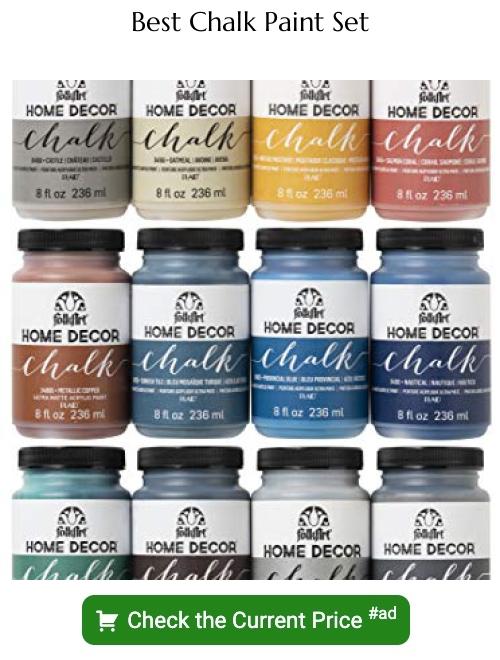Last updated on
Unlock the secrets of chalk paint, its unique properties and multitude of uses, in this comprehensive guide.
Key takeaways:
- Chalk paint has a matte, velvety finish and can be used on wood, metal, and glass.
- It requires minimal prep work and adheres well to surfaces without sanding or priming.
- Chalk paint is easy to distress and can create vintage, shabby-chic looks.
- It is water-based, low in VOCs, and dries quickly.
- Chalk paint can be sealed with wax or varnish for added durability and protection.
Definition of Chalk Paint
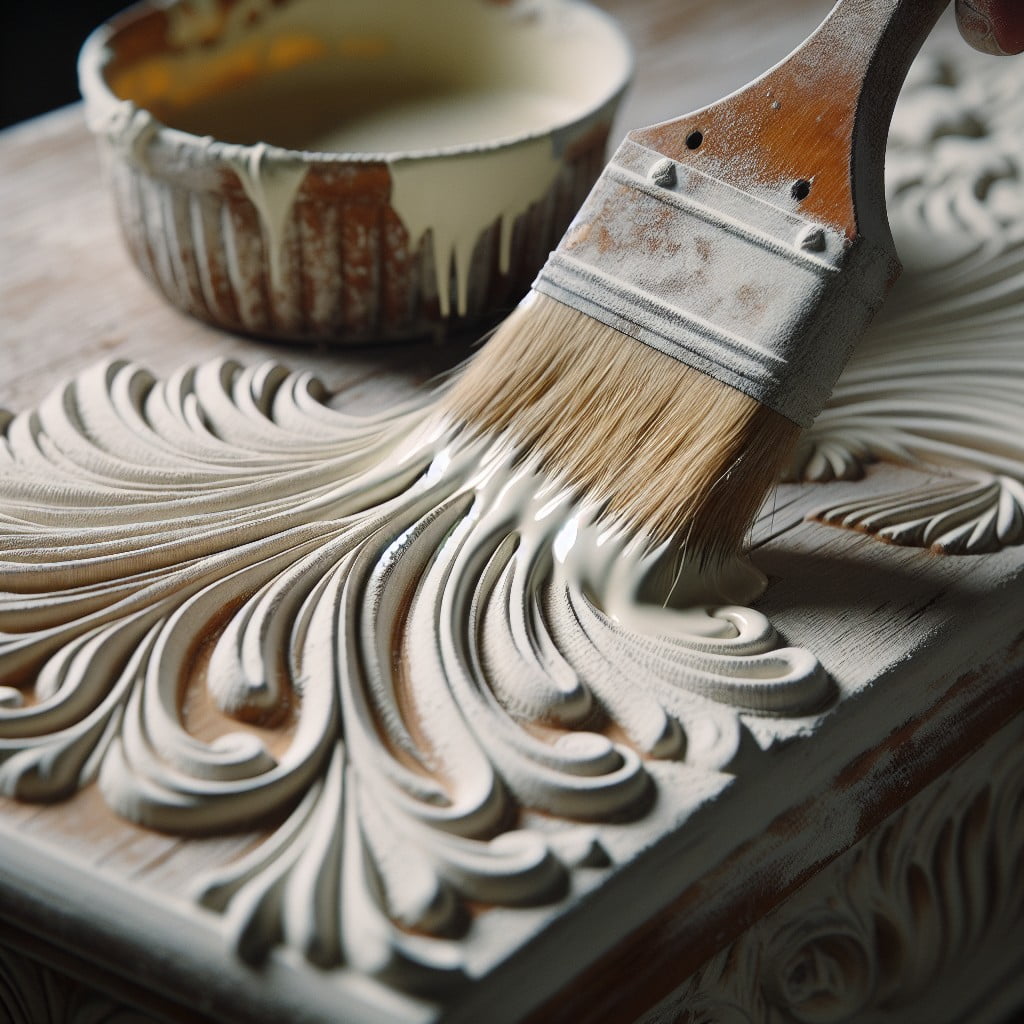
Chalk paint is a decorative paint known for its matte, velvety finish. It typically adheres to surfaces without requiring extensive pre-sanding or priming, making it a favorite for upcycling furniture and DIY projects.
The paint’s distinct feature comes from the inclusion of calcium carbonate, which gives it a chalky appearance. Its versatility allows it to be used on wood, metal, and glass, and when diluted, it can create a wash or dye effect.
Moreover, chalk paint is easy to distress, adding to its appeal for creating vintage, shabby-chic looks. Additionally, it’s water-based, which means it’s low in volatile organic compounds (VOCs) and has a quick dry time, contributing to its eco-friendliness and convenience.
Composition and Characteristics of Chalk Paint
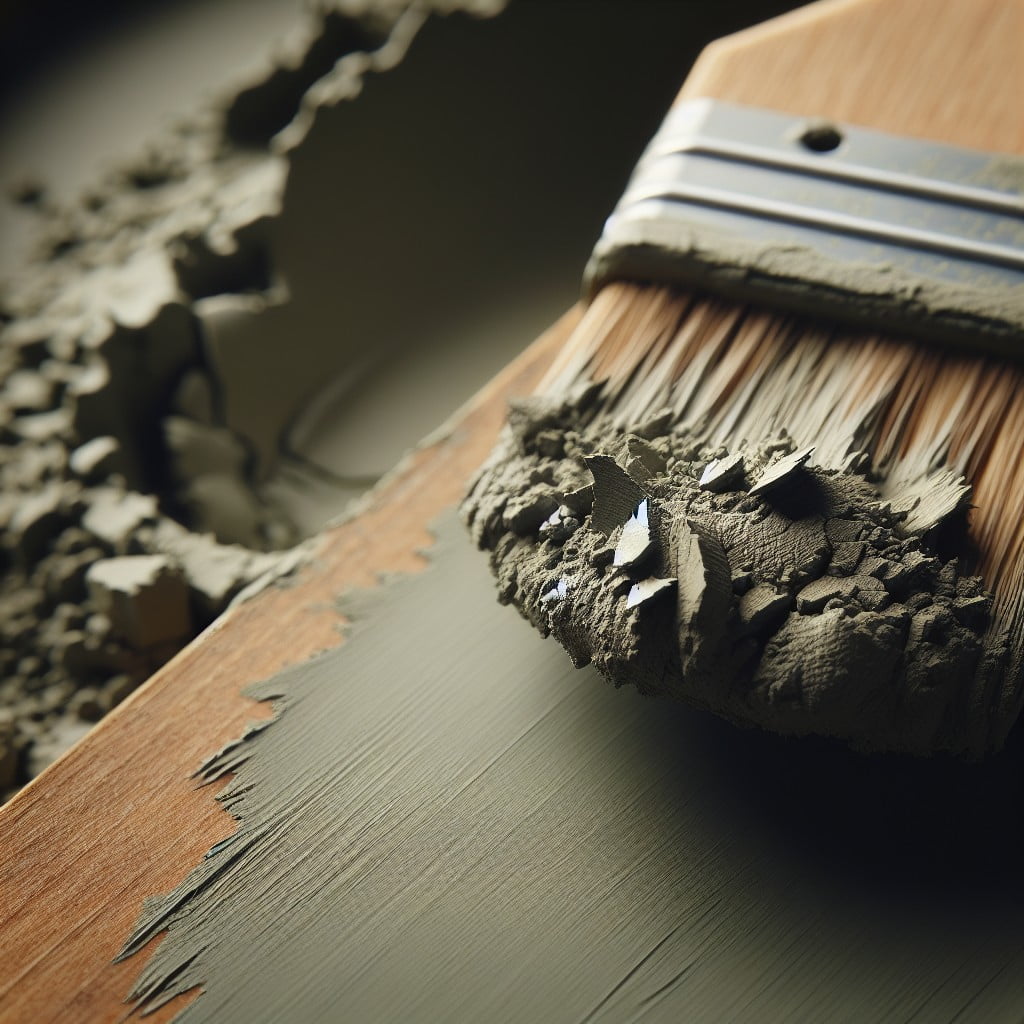
Chalk paint is renowned for its matte, velvety finish, which is a result of its unique ingredients. It is typically composed of calcium carbonate (chalk), talc, and pigments, mixed into a water-based acrylic medium. This blend is what imparts the highly opaque coverage and smooth texture chalk paints are known for.
One notable characteristic is its thick consistency which allows for excellent coverage, often requiring fewer coats compared to traditional paints. Furthermore, the high pigment concentration results in vibrant colors that can be easily distressed for a vintage look.
The versatility of chalk paint is evident in its adherence to a range of surfaces without the need for priming or sanding. Whether it’s wood, metal, ceramic, or glass, this paint can bond well, making it a favorite for upcycling furniture and decorative items.
Moreover, its water-based formulation means it has low volatile organic compounds (VOCs), which makes it more environmentally friendly and less odorous than many oil-based alternatives. This property also speeds up drying times, allowing for quicker completion of projects.
Benefits of Using Chalk Paint
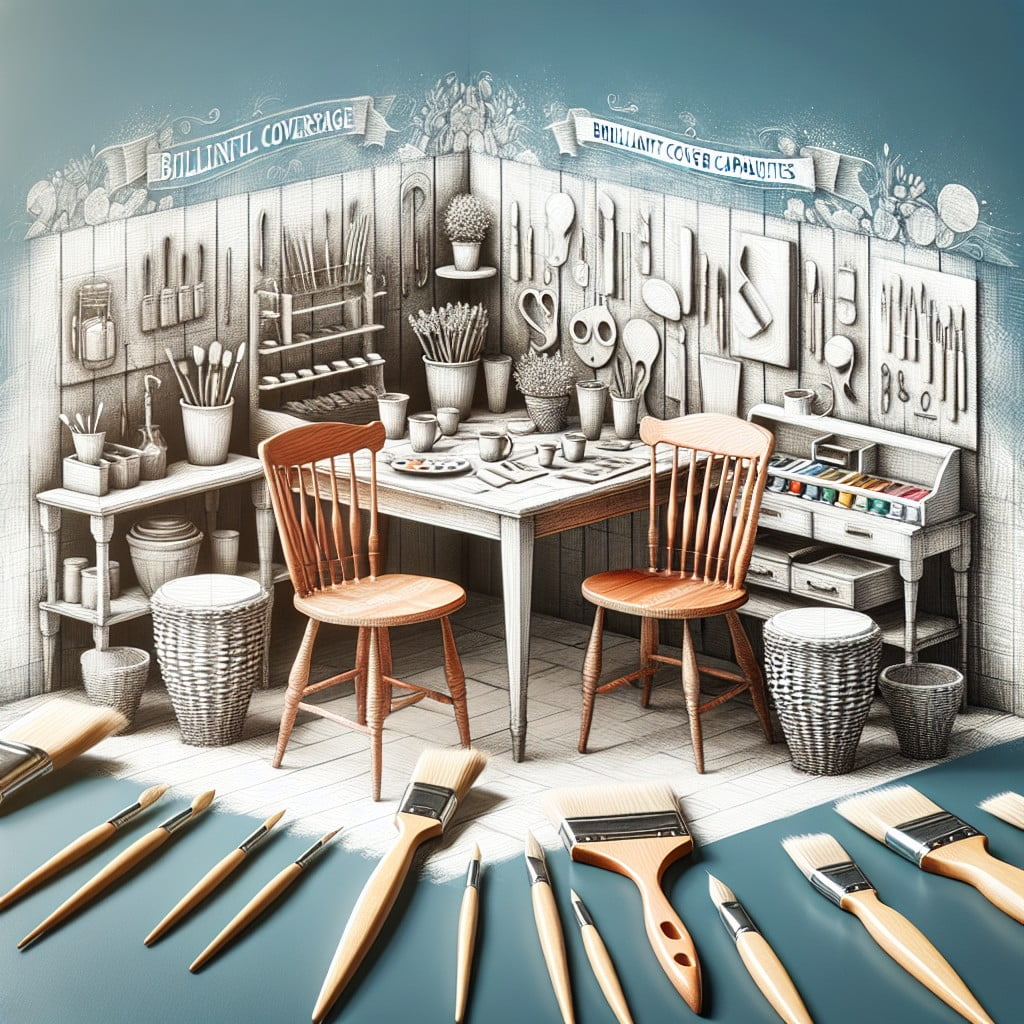
Chalk paint boasts a unique matte finish that brings a vintage flair to any piece. With its thick consistency, it often requires no prior sanding or priming, making it a time-saver for DIY enthusiasts.
This versatile paint adheres to a wide range of surfaces from wood to metal and even glass, meaning nearly any item can be transformed without cumbersome prep work.
One of the joys of working with chalk paint is its forgiving nature; brush strokes and imperfections often enhance the character of the final piece. For those looking to customize their work, it easily mixes with other hues to create custom colors.
Cleanup is a breeze as well, as it is water-based, a feature that also contributes to its low odor, making it more pleasant to use indoors.
Comparison Between Chalk Paint and Regular Paint
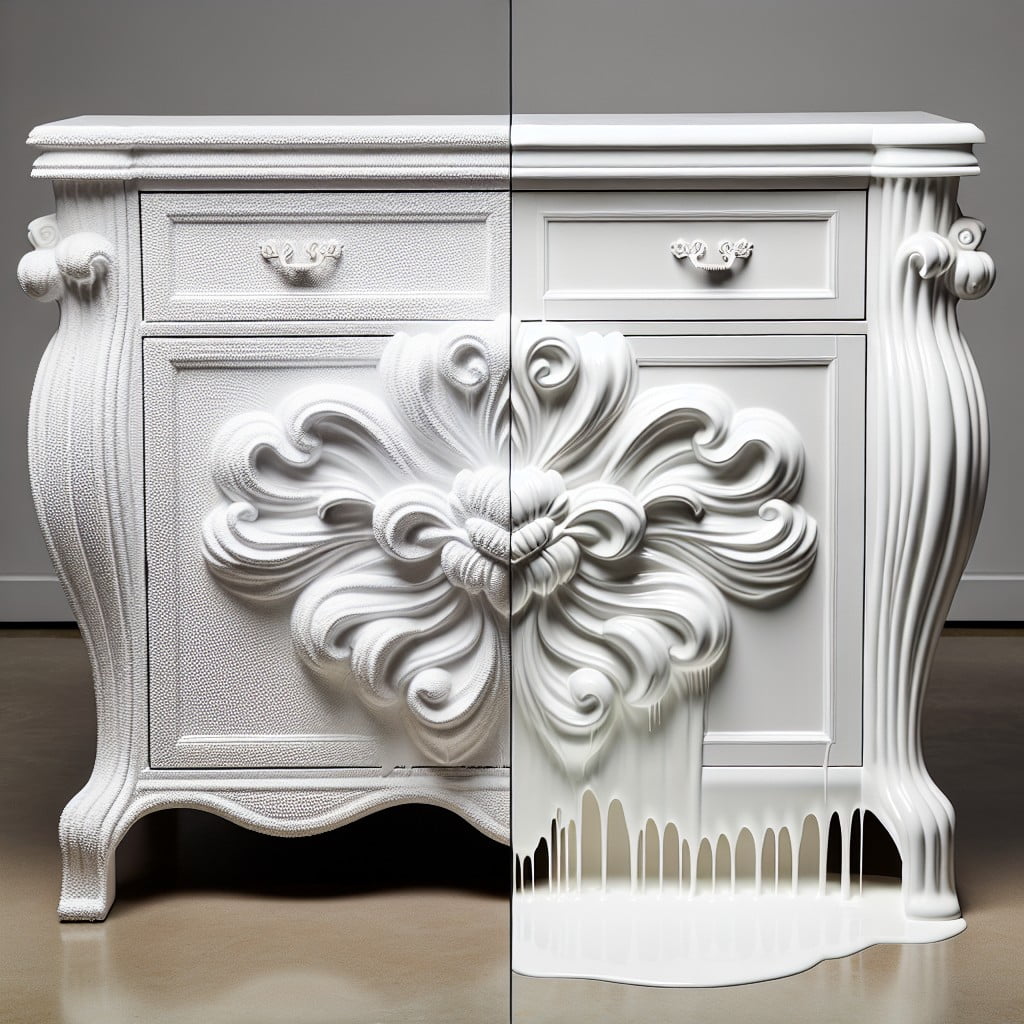
Chalk paint and regular paint cater to different finishing preferences and project requirements. While regular latex or oil-based paints offer a more glossy and smooth finish, chalk paint is prized for its matte, velvety texture.
One of chalk paint’s notable advantages is its ability to adhere to a variety of surfaces without the need for extensive prep work such as sanding or priming. This makes it a go-to for furniture restoration and decorative pieces.
In contrast, using regular paint typically involves a thorough surface preparation to ensure the paint adheres properly and provides a durable finish. Chalk paint’s consistency is thicker, which means it can cover imperfections easily, and it’s often applied with brush strokes that add character. Regular paint tends to be thinner and may require multiple coats for opaque coverage.
When considering drying time, chalk paint dries quicker, allowing projects to be completed in a shorter timeframe. Yet, it usually requires a finishing wax or sealant for protection, whereas regular paint generally has a built-in sealer.
In terms of clean up, water-based regular paints and chalk paints are both user-friendly, as they can be cleaned with soap and water, but oil-based regular paints require solvents for cleaning brushes and spills. Chalk paint, being water-based, also emits lower levels of volatile organic compounds (VOCs), making it more environmentally friendly and safer for indoor use compared to high-VOC oil-based paints.
Application Techniques for Chalk Paint
To achieve a smooth, effortless finish with chalk paint, consider these tips:
- Use a high-quality brush specifically designed for chalk paint to avoid streaks and shed bristles.
- Employ a minimalistic approach with your brush strokes, applying paint with even, fluid movements to reduce visible lines.
- Embrace the paint’s naturally thick consistency; there’s seldom a need to dilute with water, but if the paint is overly thick, a slight dilution might help.
- Opt for multiple thin layers rather than one thick coat to ensure an even, durable finish.
- For a distressed look, apply two contrasting colors in layers, then sand gently after drying to reveal areas of the base color.
- While rollers can expedite the process on larger flat areas, they may leave a texture that differs from brush strokes.
- For tight spots or intricate details, consider a small artist brush to maintain precision and control.
Remember, part of the paint’s charm is its versatility, so don’t hesitate to experiment with different techniques to achieve your desired look.
Surface Preparation for Chalk Paint
Ensuring a clean surface is vital before starting your painting project; remove any dust or grime with a damp cloth.
If you’re working with a particularly slick or glossy surface, a light sanding can help the paint adhere better.
There’s no need for a primer with most chalk paints, but for woods that are prone to bleeding, such as mahogany or cherry, an initial coat of blocking primer prevents discoloration.
Fix any imperfections like cracks or dents with wood filler for an even finish.
Allow the surface to dry completely before applying the paint to avoid trapping moisture.
Chalk paint adheres well to most surfaces, but it’s always a good practice to test a small area first to ensure compatibility.
Detailed Steps On How to Apply Chalk Paint
Begin by ensuring your piece is clean, dry, and free from loose paint or old wax. Lightly sanding the surface can help to create a better bond, although it’s not always necessary due to the adhesive properties of chalk paint.
Once prepped, stir the chalk paint thoroughly to ensure the pigments are well distributed. Apply the first coat using a brush or roller, working in the same direction as the grain of the wood. Don’t overwork the paint; apply it in a straightforward manner for a smooth surface.
Chalk paint dries relatively quickly, so by the time you finish your first coat, you may be ready to start the second. Before applying the second coat, lightly sand the surface with a fine-grit sandpaper for an even smoother finish. Wipe away any dust with a lint-free cloth.
Apply the second coat just like the first. Two coats are often sufficient, but if you’re working with a darker piece or want a more opaque finish, additional coats may be necessary.
Once the final coat is dry, protect your work with wax or lacquer. Apply a thin layer of wax using a cloth or brush, working it into the paint for a durable finish. If you prefer lacquer, follow the manufacturer’s instructions, as it may require a different application process.
Lastly, allow your piece to fully cure. While chalk paint dries to the touch quickly, the curing process can take up to 30 days, during which the paint hardens and becomes more durable. Treat the piece gently during this time to ensure the best result.
Tips for Achieving a Professional Finish With Chalk Paint
To ensure a smooth application, begin by stirring your chalk paint thoroughly to achieve a consistent color and texture. When applying the paint with a brush, use long, even strokes to minimize brush marks. If you prefer a brushed look, apply the paint in every direction for a more handcrafted appearance.
Sanding between coats can make a significant difference—the fine grit sandpaper smooths out any buildup and allows subsequent layers to adhere better, resulting in an even, professional finish. Aim to apply at least two coats for opaque coverage, allowing ample time for each layer to dry before adding another.
If you find any imperfections or drip marks, gently sand them away once the paint is dry. This will create the perfect base for your chosen sealant, whether it be wax, polyurethane, or another protective finish.
When sealing your work, apply the product with a clean, lint-free cloth or a soft brush in thin, uniform coats. Be patient as you work, since rushing can lead to a less than smooth finish. Allow proper drying time based on the manufacturer’s recommendations before using or handling the painted surface.
Remember, the beauty of chalk paint lies in its versatility. Embrace the subtly distressed look or go for a sleek, modern aesthetic by refining your technique to create the desired effect.
Common Projects and Surfaces Suitable for Chalk Paint
Chalk paint adheres to a variety of surfaces, making it a versatile choice for both amateur and professional projects alike. Furniture, such as dressers, tables, and chairs, transform beautifully with this paint due to its ability to cover imperfections and create a matte, vintage look. Wood pieces, even without sanding, are ideal candidates for its application.
Beyond wood, this paint is equally effective on metal, ceramic, glass, and even fabric, offering creative freedom across various mediums. Kitchen cabinets and decorative items take on new life with a coat of chalk paint, providing an instant upgrade without extensive prep work. Walls can also benefit from its distinctly soft, chalky texture when aiming for a statement finish or an aged appearance.
Crafters find its thick consistency perfect for creating distressed or shabby chic effects on picture frames, vases, and other small décor items. It’s also suitable for stenciling due to its minimal bleeding. Remember, chalk paint’s unique properties not only make it simple to apply but also endow your projects with a charming, timeless look.
Drying Time and Number of Coats Required for Chalk Paint
Quick to dry, chalk paint typically sets to the touch within 30 minutes to an hour. However, it’s advisable to wait about 24 hours before applying a second coat to ensure thorough drying and adherence.
Most projects will require one to two coats for full coverage. The number of coats depends on the color and technique:
- Lighter shades may necessitate additional layers to achieve an opaque finish.
- To maintain texture or for distressed looks, fewer coats are often used.
- Always apply thin and even coats rather than a single thick layer to prevent cracking.
Before adding supplemental layers, ensure the previous has completely dried to the touch. For the best results, lightly sand between coats to promote a smooth, even texture. When completely dry, painted surfaces exhibit a characteristic matte finish.
Options for Sealing and Protecting Chalk Paint
Once your chalk paint project is dry, sealing it properly not only enhances the color and adds a preferred finish but also protects your work from wear and tear. The most common sealants are wax and varnish. Wax provides a soft, velvety finish and is perfect for items with moderate use. It’s easy to apply with a cloth or brush, though it may require reapplication over time to maintain protection.
Varnish or polyurethane offers a more durable finish and is an excellent choice for heavily used items like kitchen cabinets or tabletops. There are different sheens available, from matte to glossy, depending on the desired look. For a less toxic option, consider using a water-based polycrylic sealant, which has the advantage of not yellowing over time.
Alternatively, for a more aged look, glazes or dark waxes can be applied. These products not only seal the paint but also highlight brush strokes and edges, adding character to the piece.
When applying any sealant, ensure the paint is completely dry and apply with a gentle hand in thin, even coats. Always follow the manufacturer’s instructions for the best results, and remember that time invested in properly sealing your work will significantly extend its life and beauty.
Durability and Maintenance of Chalk Paint Surfaces
Despite its matte finish, chalk paint can withstand the test of time if properly maintained. To maximize durability, applying a wax or sealant over the painted surface is recommended. This additional layer not only enhances the paint’s resilience against wear and tear but also makes it easier to clean. Use a gentle cleaning solution and a soft cloth for routine surface cleanup to avoid any damage to the protective coating.
In high-traffic areas or on surfaces that are frequently touched, retouching may be necessary over time. Fortunately, refreshing a piece with chalk paint is effortless; a light sanding and an additional coat can restore its original luster. For daily wear, minor marks and scratches are simple to fix with a dab of paint and a small brush.
Regular care will ensure that your chalk-painted pieces maintain their beauty and functionality for years to come, allowing you to enjoy the fruits of your labor without undue concern for the fragility of the finish.
Popular Brands and Lines of Chalk Paint
Annie Sloan stands at the forefront of the chalk paint movement with her trademark range that sparked widespread popularity. Renowned for its reliability and rich pigmentation, these paints come in a variety of vintage shades suitable for a range of projects.
Rust-Oleum provides a budget-friendly alternative that doesn’t skimp on quality. Their chalked paint line offers easy application and a velvety smooth finish, making it a go-to choice for both beginners and seasoned DIY enthusiasts.
FolkArt Home Décor Chalk is another notable mention, especially for crafters. This brand offers a diverse palette and is known for its ultra-matte finish, perfect for those looking to achieve a classic, chalky texture on small-scale items.
Americana Décor Chalky Finish paint by DecoArt is gaining traction for its fast drying time and minimal prep claim. It presents users with a mix of traditional and contemporary color options suitable for furniture and home decor.
These brands, each with their own features and color ranges, cater to various preferences and project requirements, ensuring a choice for any revamp or restoration endeavor. Always check for compatibility with your intended surface, and keep an eye out for the specific attributes that align with your project goal.
Color Options Available in Chalk Paint
One of the appeal factors of chalk paint is its versatility in color choices. With an extensive palette, ranging from soft pastels to vibrant hues, the options cater to every taste and project.
Pastel tones work well for creating a vintage or shabby chic look, while bolder colors can make a striking statement piece. Neutral shades offer a timeless finish, fitting effortlessly into any decor style.
For those with a specific color in mind, some brands offer color mixing services, allowing for even more customization. Additionally, because chalk paint has a matte finish, colors often appear more muted, giving them a unique depth that can enhance the character of furniture or other painted items.
For an artisanal flair, users can explore the technique of layering different colors, which can result in a rich, complex finish once the top layers are distressed to reveal the underlying shades. This layering method allows for creative expression and customization.
Seasonal trends also influence the color offerings with chalk paint brands, so it’s worth keeping an eye on the latest color releases that can refresh or update a space according to the current styles.
FAQ
What is the difference between chalk paint and regular paint?
Chalk paint differs from regular paint primarily due to its capacity to be directly applied to a surface with minimal preparation such as sanding or priming, provided the surface is clean and decluttered.
What is so special about chalk paint?
Chalk paint is special due to its unique property that allows it to be applied over most clean, dry surfaces, including previously painted ones, without any preparation work.
What are the disadvantages of chalk paint?
One of the key disadvantages of chalk paint is its high porosity, which makes it susceptible to absorbing stains and appearing unkempt quickly unless adequately sealed.
Does chalk paint need to be sealed?
While chalk paint does not require sealing, it is often recommended for better protection from damage, stains, and excessive wear, and to improve the tactile feel of the painted object.
How is chalk paint typically applied and on what surfaces?
Chalk paint is typically applied with a brush or roller in two coats for full coverage on surfaces such as wood, metal, or even fabric.
Can chalk paint be used outdoors, and how does it weather?
Yes, chalk paint can be used outdoors; however, its performance varies with the weather as it may require a sealant to protect it from moisture and UV rays.
What are the common techniques for distressing and finishing with chalk paint?
Common techniques for distressing and finishing with chalk paint include sanding, waxing, cracking, and using antique glazes for desired vintage effects.
Recap:
